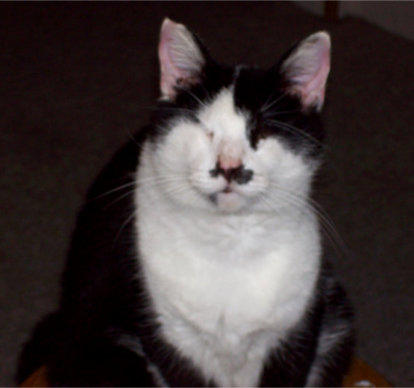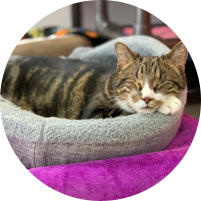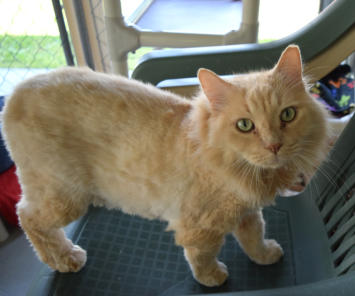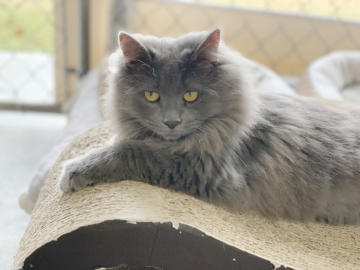Blind Cat Rescue was started in 2005 in St Pauls, NC (USA) by a
mother and daughter team to answer the
need for a safe place for blind cats that were deemed not
adoptable by regular shelters. They were going
to be killed just because they are blind.
We got our first blind cat Louie when we were volunteering for
the local shelter. A man was going to leave this 6 week old in the
Petsmart parking lot if the shelter would not accept him. I found
myself saying “I will take him.”
Louie showed us just how normal a blind cat is. He climbed, ran,
played and loved like a “normal” cat. He did not know he was
blind, he knew he was a cat, he behaved like a “normal” cat.
Then we got our second, third, and fourth blind cat. We
discovered there were no resources for blind cats. They were
regularly killed at shelters because they were considered not adoptable. In North Carolina it is actually in the law. If an
animal is sick, injured or blind it may be killed immediately in animal control facilities. We feel we do
not kill humans because they are blind, why on earth would you kill an animal for the same thing? We knew from living
with blind cats that they are just normal cats. They have no clue they are blind, they know they are cats, they act like cats.
We decided it was time to do it right and applied to become a non profit and 501©3 charity.
Who would have ever dreamed what would have come from those four words?

Bear - FIV+
What is FIV (Feline Immunodeficiency Virus
FIV is a lentivirus, a slow-progressing virus that can compromise a cat’s immune system, reducing its ability to fight off
illnesses. The virus has a long latent period then progresses so slowly that it may never affect a cat. That’s why long-term
studies show what guardians and rescuers have known for decades—that FIV cats can live just as long and as healthy, and
ultimately die of the same causes as Non-FIV cats. And, FIV cats can live with Non-FIV cats without spreading the virus.
FIV is difficult to spread. The virus is fragile and does not survive long in the environment. It is killed by air, light, heat and
regular household disinfectants.
FIV is primarily transmitted through a deep, penetrating bite (FIV cat to Non-FIV cat) where the virus (in the saliva) is injected
directly into the bloodstream of the Non-FIV cat. Bites of this kind are extremely rare, except in free-roaming, un-neutered
tomcats.
New studies done by Purdue University College of Veterinary Medicine shows that positive and negative cats can live
together with no problems. FIV is spread by deep bloody biting fighting. Unfixed cats outside struggling for food and
resources fight. Neuter them and feed them there is no reason to fight. Occasionally it is spread by a positive mother to her
babies, but that is not as common. An FIV+ cat can live for years before becoming sick. When a cat reaches the point that our
vet feels we can no longer provide them quality of life, we hold them and humanly let them go. We do not allow them to
suffer.
We have had positive and negative FIV+ cats together for over 10 years and have never had a negative test positive. They are
tested yearly as part of their regular blood work
In 2011 we began providing a safe sanctuary for FELV+ (leukemia positive) and FIV+ (feline immunodeficiency virus) cats.
FIV & FELV+ cats are killed daily at vets offices and shelters because they test positive for these
viruses. We do not kill people because they have an immune system illness or leukemia, why would we kill a healthy
animal because they test positive?
Sadly if retested with a more accurate test before being killed, some would actually be false positives. NEVER EVER accept
the results from a snap test if your cat tests positive! (That is the test your vet will have used) INSIST that they be retested
with the IFA test for leukemia or Western Blot test for FIV. The test has to be sent out to an outside lab.
If your cat test FIV+ and your vet suggest you kill it please find a better vet.
New studies done by Purdue University College of Veterinary Medicine shows that positive and negative cats can live
together with no problems. FIV is spread by deep bloody biting fighting. Unfixed cats outside struggling for food and
resources fight. Neuter them and feed them there is no reason to fight. Occasionally it is spread by a positive mother to
her babies, but that is not as common. An FIV+ cat can live for years before becoming sick. When a cat reaches the point
that our vet feels we can no longer provide them quality of life, we hold them and humanly let them go. We do not allow
them to suffer.
Chester & Meghan - FELV+
Feline leukemia virus (FeLV) is second only to trauma as the leading cause of death in cats, killing 85% of persistently infected
felines within three years of diagnosis. The virus commonly causes anemia or lymphoma, but because it suppresses the
immune system, it can also predispose cats to deadly infections.
FELV+ Feline leukemia is passed from one cat to another through saliva, blood, and to some extent, urine and feces. The virus
does not live long outside the cat’s body - probably less than a few hours under normal household conditions. If your cat tests
positive for FELV, the cat is not sick and your vet suggest you kill the cat, find a better vet. We do not kill humans because they
have a virus, why would we murder the cat? It is our experience that a FELV+ cat can have a few years of healthy life before they
become sick from the virus. We have several that are currently 9 years old. We do find that 3-5 is more the average. Although
they also could die younger from secondary illness’s or lymphoma.
The Snap test your vet used is known for many false positives. If your cat test positive please insist on the cat being retested
using the IFA test (Idexx lab test number 7171) before making any life changing decisions. The test takes a few days to come
back from the lab. If the test is positive, the virus is showing in the cat’s bone marrow and sadly your cat is positive.
About Blind Cats
Facts about blind cats:
Blind Cats do not know they are blind, they know they are cats. They act likes “normal” cats.
Blind cats can do pretty much everything that a seeing cat can do. They can climb trees, climb up on to the top of cabinets
and get into places that you can not figure out how they did it.
Some things that will make it easier on your blind cat is to try to stay some what consistent on the important things, like the
litter box and food bowls. For the rest of the house, live normally; they will go around things. If you watch a blind cat, you
will see that they point their whiskers out so the whiskers will brush against something typically before they hit it. You CAN
move your furniture. They will quickly readjust to the change.
If you pick up a blind cat and move him/her from point A to point B, try to put them down where
they have a good idea of where they are: in
the litter box, at their food bowl or where floors have different textures. A cat can become blind
from many things. If your cat has suddenly become blind over night, RUSH the cat to the vet
immediately! Insist on them checking the cat’s blood pressure. (That is not something done
automatically at most vets) IF the blindness is from hypertension and
caught fast enough, it may reverse with medicine.
They can also become blind from diabetes, hyperthyroid and most commonly an untreated upper respiratory infection.
If your cat is sneezing, coughing and eyes are gooey, get to the vet.
If your cat is eating like crazy and losing weight or drinking water like there is no tomorrow RUN to the vet! Make sure you
allow your vet to do full blood work on your cat! They need all the tools you can give them to properly diagnose your cat.
We are a registered non-profit with the state of North Carolina. We are a 501(c)3. Our tax number is 20-3410498.
Please, if you believe that blind, FIV+ or FELV+ cats deserve to have an opportunity to live instead of being declared
not adoptable and immediately killed, help us have the resources to help them.
Your donations are tax deductible and encrypted. You may use Mastercard, Visa or Paypal.
Please say YES to helping the blind, FIV and FELV+ cats. Please Donate Now!

About Us






Thank you to our sponsors!
ADDRESS - Mailing
3101 E Great Marsh Church Road
St Pauls, NC 28384
Shelter:
74 Prairie Lane, St Pauls NC 28384
Memorials - page 1
Memorials - page 2
Memorials - page 3
Memorials - page 4
Memorials - page 5
Memorials - page 6
Memorials - page 7
Memorials - page 8
Memorials - page 9
Memorials - page 10
Memorials - page 11
Memorials - page 12
Sections

Sponsor
Send a gift - wishlist
Donate Now
Donate Monthly
Ebay
Donate your car
Donate your birthday
CFC



About Us
Blind Cat Rescue was
started in 2005 in St
Pauls, NC (USA) by a
mother and daughter
team to answer the
need for a safe place for
blind cats that were
deemed not adoptable by
regular shelters. They
were going to be killed just because they are blind.
We got our first blind cat Louie when we were volunteering
for the local shelter. A man was going to leave this 6 week
old in the Petsmart parking lot if the shelter would not
accept him. I found myself saying “I will take him.”
Louie showed us just how normal a blind cat is. He
climbed, ran, played and loved like a “normal” cat. He did
not know he was blind, he knew he was a cat, he behaved
like a “normal” cat.
Then we got our second, third, and fourth blind cat. We
discovered there were no resources for blind cats. They
were regularly killed at shelters because they were
considered not adoptable. In North Carolina it is actually in
the law. If an animal is sick, injured or blind it may be
killed immediately in animal control facilities. We feel we
do
not kill humans because they are blind, why on earth would
you kill an animal for the same thing? We knew from
living with blind cats that they are just normal cats. They
have no clue they are blind, they know they are cats, they
act like cats. We decided it was time to do it right and
applied to become a non profit and 501©3 charity.
Who would have ever dreamed what would have come
from those four words? +
In 2011 we began providing a safe sanctuary for FELV+
(leukemia positive) and FIV+ (feline immunodeficiency
virus) cats. FIV & FELV+ cats are killed daily at vets
offices and shelters because they test positive for these
viruses. We do not kill people because they have an
immune system illness or leukemia, why would we kill a
healthy animal because they test positive?
Sadly if retested with a more accurate test before being
killed, some would actually be false positives. NEVER
EVER accept the results from a snap test if your cat tests
positive! (That is the test your vet will have used) INSIST
that they be retested with the IFA test for leukemia or
Western Blot test for FIV. The test has to be sent out to an
outside lab.
What is FIV (Feline Immunodeficiency Virus?
Feline immunodeficiency virus is a Lentivirus that affects
cats worldwide, with 2.5% to 4.4% of felines being
infected. FIV differs taxonomically from two other feline
retroviruses, feline leukemia virus and feline foamy virus,
and is more closely related to human immunodeficiency
virus. FIV is the only non-primate lentivirus to cause an
AIDS-like syndrome, but FIV is not typically fatal for cats,
as they can live relatively healthily as carriers and
transmitters of the disease for many years.
If your cat test FIV+ and your vet suggest you kill it please
find a better vet.

Feline leukemia Virus - FELV
(FeLV) is second only to trauma as the leading cause of
death in cats, killing 85% of persistently infected felines
within three years of diagnosis. The virus commonly
causes anemia or lymphoma, but because it suppresses
the immune system, it can also predispose cats to deadly
infections.
FELV+ Feline leukemia is passed from one cat to
another through saliva, blood, and to some extent, urine
and feces. (That is according to “experts) We disagree
with them. We know it is not spread from food bowls,
water bowls or litterboxes. We have had positive and
negatives together now for over 3 years (It was
accidental) The negatives are all vaccinated against
leukemia. No one has become positive. We do feel it is
spread by serious grooming. The virus does not live
long outside the cat’s body - probably less than a few
hours under normal household conditions. If your cat
tests positive for FELV, the cat is not sick and your vet
suggest you kill the cat, find a better vet. We do not kill
humans because they have a virus, why would we
murder the cat? It is our experience that a FELV+ cat
can have a few years of healthy life before they become
sick from the virus. We have several that are currently 9
years old. We do find that 3-5 is more the average.
Although they also could die younger from secondary
illness’s or lymphoma.
.The Snap test your vet used is known for many false
positives. If your cat test positive please insist on the cat
being retested using the IFA test (Idexx lab test number
7171) before making any life changing decisions. The
test takes a few days to come back from the lab. If the
test is positive, the virus is showing in the cat’s bone
marrow and sadly your cat is positive.
About Blind Cats
Facts about blind cats:
Blind Cats do not know they are blind, they know they are
cats. They act likes “normal” cats.
Blind cats can do pretty much everything that a seeing cat
can do. They can climb trees, climb up on to the top of
cabinets and get into places that you can not figure out
how they did it.
Some things that will make it easier on your blind cat is to
try to stay some what consistent on the important things,
like the litter box and food bowls. For the rest of the house,
live normally; they will go around things. If you watch a
blind cat, you will see that they point their whiskers out so
the whiskers will brush against something typically before
they hit it. You CAN move your
furniture. They will quickly
readjust to the change.
If you pick up a blind
cat and move him/her
from point A to point
B, try to put them down
where they have a good
idea of where they are: in
the litter box, at their food bowl or where floors have
different textures. A cat can become blind from many
things. If your cat has suddenly become blind over night,
RUSH the cat to the vet immediately! Insist on them
checking the cat’s blood pressure. (That is not something
done automatically at most vets) IF the blindness is from
hypertension and caught fast enough, it may reverse with
medicine.
They can also become blind from diabetes, hyperthyroid
and most commonly an untreated upper respiratory
infection.
If your cat is sneezing, coughing and eyes are gooey, get
to the vet.
If your cat is eating like crazy and losing weight or
drinking water like there is no tomorrow RUN to the vet!
Make sure you allow your vet to do full blood work on
your cat! They need all the tools you can give them to
properly diagnose your cat.
We are a registered non-profit with the state of North
Carolina. We are a 501(c)3. Our tax number is 20-
3410498.
Please, if you believe that blind, FIV+ or FELV+ cats
deserve to have an opportunity to live instead of being
declared
not adoptable and immediately killed, help us have the
resources to help them.
Your donations are tax deductible and encrypted. You may
use Mastercard, Visa or Paypal.
Please say YES to helping the blind, FIV and FELV+ cats.
Please Donate Now!

FIV is a lentivirus, a slow-progressing virus that can
compromise a cat’s immune system, reducing its ability to
fight off illnesses. The virus has a long latent period then
progresses so slowly that it may never affect a cat. That’s
why long-term studies show what guardians and rescuers
have known for decades—that FIV cats can live just as
long and as healthy, and ultimately die of the same causes
as Non-FIV cats. And, FIV cats can live with Non-FIV cats
without spreading the virus.
FIV is difficult to spread. The virus is fragile and does not
survive long in the environment. It is killed by air, light,
heat and regular household disinfectants.
FIV is primarily transmitted through a deep, penetrating
bite (FIV cat to Non-FIV cat) where the virus (in the
saliva) is injected directly into the bloodstream of the Non-
FIV cat. Bites of this kind are extremely rare, except in
free-roaming, un-neutered tomcats.
New studies done by Purdue University College of
Veterinary Medicine shows that positive and negative cats
can live together with no problems. FIV is spread by deep
bloody biting fighting. Unfixed cats outside struggling for
food and resources fight. Neuter them and feed them there
is no reason to fight. Occasionally it is spread by a
positive mother to her babies, but that is not as common.
An FIV+ cat can live for years before becoming sick.
When a cat reaches the point that our vet feels we can no
longer provide them quality of life, we hold them and
humanly let them go. We do not allow them to suffer.
We have had positive and negative FIV+ cats together for
over 10 years and have never had a negative test positive.
They are tested yearly as part of their regular blood work.

Bear - FIV+

Donate Now
Donate Monthly
Sponsor
Wishlist
Other ways to help
Ebay
Donate your car
Donate your birthday
CFC
Amazon Smile
Sections




Thank you to our sponsors!





Meredith - FELV+
Thank you to our sponsors!






















